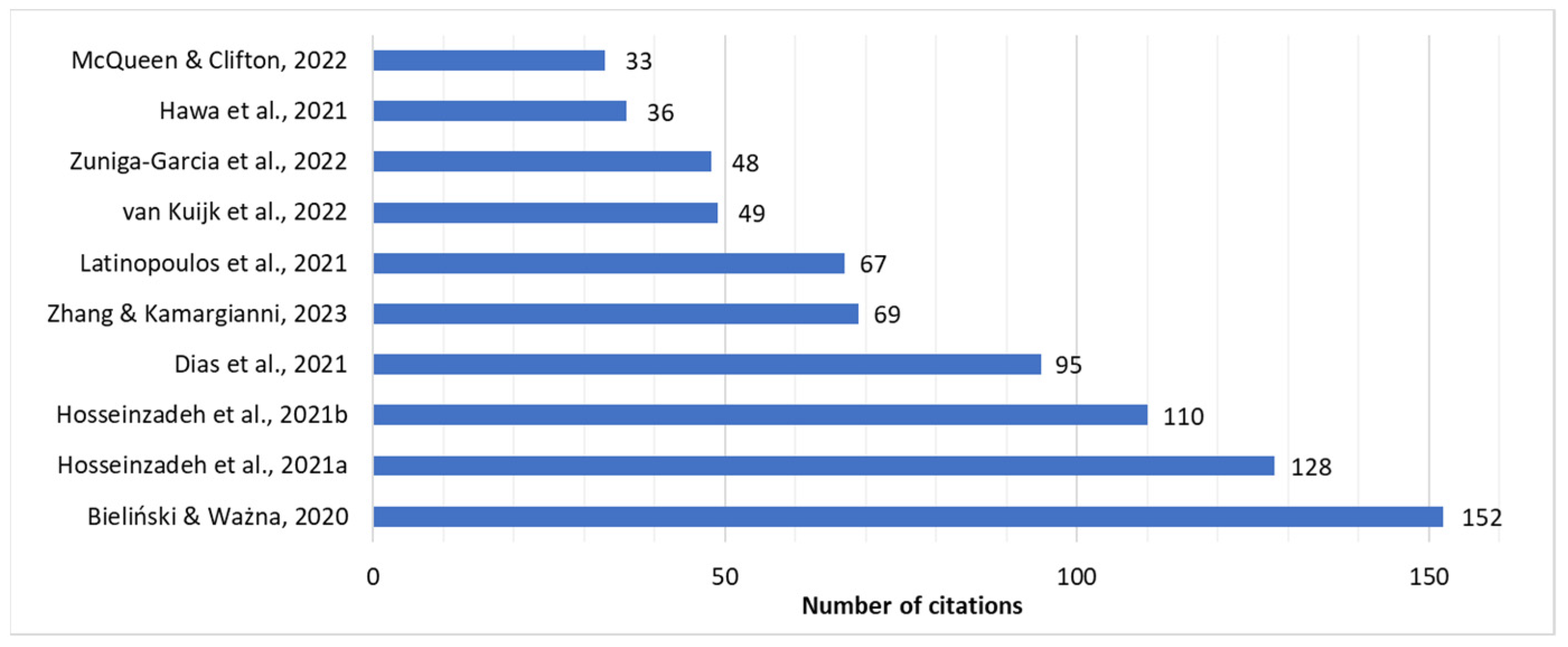Green Micromobility-Based Last-Mile Logistics from Small-Scale Urban Food Producers
Abstract
1. Introduction
2. Literature Review
2.1. Descriptive Analysis of Available Research Results
2.2. Content Analysis of Available Research Results
2.3. Critical Analysis of Published Research Results and Research Gap Identification
3. Materials and Methods
- Homogeneous delivery tasks within a time window: Deliveries are planned within predefined time windows, and demand is known at the beginning of the optimization process.
- Vehicle characteristics are fixed: The capacity, speed, and emission factors of micromobility vehicles are considered constant during the planning horizon.
- No partial deliveries: Each delivery task is assigned in full to one or more vehicles, but cannot be split across different time windows.
- Deterministic input data: Product supply, customer demand, travel distances, and costs are assumed to be accurately known and do not vary during the optimization.
- Stable operating conditions: Road conditions, weather, and traffic are assumed not to cause unexpected disruptions within the optimization horizon.
4. Results
4.1. Case Study with Simulated Data
- It serves as a means of model validation in a controlled environment. By working with simulated data, we can ensure that all parameters are clearly defined, the constraints are applied correctly, and the solving process can be transparently demonstrated step by step. This helps to confirm that the optimization model functions as intended before being applied to more complex and less predictable real-world datasets.
- The simulated case study plays a complementary role to the real-world analysis. While the real-world case study demonstrates the model’s practical feasibility and effectiveness under actual operating conditions, the simulated case helps to highlight the inner mechanics of the optimization and makes the methodology more accessible to readers. Together, the two cases strengthen the paper by combining methodological clarity with empirical validation.
- Set of three producers: ,
- Set of eight delivery locations (customers): ,
- Set of three product types (e.g., bread, vegetables): ,
- Delivery tasks’ volume and weight within the predefined time-window of real-time optimization, which obtains its results from the available quantity of product k at producer i in [pcs], the weight per unit of product k in [kg] and the volume per unit of product k in [dm3] (see Table 3).
- Real-time location of micromobility vehicles (cargo e-trikes and e-scooters);
- Location of producers and customers;
- Cost per unit in [EURO/pcs] (see Table 6);
- Delivery speed of vehicle i [km/h] (see Table 6);
- CO2 emission of vehicles in [g/km] (see Table 6);
- Weight capacity of one micromobility vehicle in [kg/vehicle] (see Table 6);
- Volume capacity of one micromobility vehicle in [dm3/vehicle] (see Table 6);
- Total number of available micromobility vehicles is 12.
- It can efficiently solve large-scale optimization models with binary decision variables, which are essential for modeling vehicle allocation and capacity-constrained delivery routes;
- It ensures accurate and reliable results that reflect the complexity of real-world logistics systems;
- Its integration with Excel allows for transparent data input, immediate interpretation of results, and flexible scenario analysis;
- As an open-source tool, it is cost-effective and widely applicable for both scientific research and practical logistics planning.
4.2. Case Study with Real-World Data
- Set of three producers (Sunshine, Csocsaj and Keszi Bakeries: ;
- Set of eight delivery locations (customers): ;
- Set of three product types (bread and rolls, pastries and sweet baked goods, and savory baked goods): ;
- Delivery tasks’ volume and weight within the predefined time-window of real-time optimization (see Table 9);
- Real-time location of micromobility vehicles (cargo e-trikes and e-scooters), producers (bakeries) and customers (see Table 10).
- Cost per unit in [EUR/pcs] (see Table 13),
- Delivery speed of vehicle i [km/h] (see Table 13);
- CO2 emission of vehicles in [g/km] (see Table 13);
- Weight capacity of one micromobility vehicle in [kg/vehicle] (see Table 13);
- Volume capacity of one micromobility vehicle in [dm3/vehicle] (see Table 13);
- Total number of available micromobility vehicles is 12.
5. Discussion
6. Conclusions
Author Contributions
Funding
Data Availability Statement
Conflicts of Interest
Abbreviations
| FCN | Fully Convolutional Network |
| GHG | Greenhouse Gas |
| GIS | Geographic Information System |
| MMQUAL | Micromobility Quality |
References
- Bieliński, T.; Ważna, A. Electric scooter sharing and bike sharing user behaviour and characteristics. Sustainability 2020, 12, 9640. [Google Scholar] [CrossRef]
- Hosseinzadeh, A.; Algomaiah, M.; Kluger, R.; Li, Z. E-scooters and sustainability: Investigating the relationship between the density of E-scooter trips and characteristics of sustainable urban development. Sustain. Cities Soc. 2021, 66, 102624. [Google Scholar] [CrossRef]
- Hosseinzadeh, A.; Algomaiah, M.; Kluger, R.; Li, Z. Spatial analysis of shared e-scooter trips. J. Transp. Geogr. 2021, 92, 103016. [Google Scholar] [CrossRef]
- Dias, G.; Arsenio, E.; Ribeiro, P. The role of shared e-scooter systems in urban sustainability and resilience during the COVID-19 mobility restrictions. Sustainability 2021, 13, 7084. [Google Scholar] [CrossRef]
- Zhang, Y.; Kamargianni, M. A review on the factors influencing the adoption of new mobility technologies and services: Autonomous vehicle, drone, micromobility and mobility as a service. Transp. Rev. 2023, 43, 407–429. [Google Scholar] [CrossRef]
- Latinopoulos, C.; Patrier, A.; Sivakumar, A. Planning for e-scooter use in metropolitan cities: A case study for Paris. Transp. Res. D Transp. Environ. 2021, 100, 103037. [Google Scholar] [CrossRef]
- van Kuijk, R.J.; de Almeida Correia, G.H.; van Oort, N.; van Arem, B. Preferences for first and last mile shared mobility between stops and activity locations: A case study of local public transport users in Utrecht, the Netherlands. Transp. Res. A Policy Pract. 2022, 166, 285–306. [Google Scholar] [CrossRef]
- Zuniga-Garcia, N.; Tec, M.; Scott, J.G.; Machemehl, R.B. Evaluation of e-scooters as transit last-mile solution. Transp. Res. C Emerg. Technol. 2022, 139, 103660. [Google Scholar] [CrossRef]
- Hawa, L.; Cui, B.; Sun, L.; El-Geneidy, A. Scoot over: Determinants of shared electric scooter presence in Washington D.C. Case Stud. Transp. Policy 2021, 9, 418–430. [Google Scholar] [CrossRef]
- McQueen, M.; Clifton, K.J. Assessing the perception of E-scooters as a practical and equitable first-mile/last-mile solution. Transp. Res. A Policy Pract. 2022, 165, 395–418. [Google Scholar] [CrossRef]
- Alcock, R.J. Mathematical Decision Making for Planetary Health: Community-Engaged Design and Optimization of Last-Mile Health and Transportation Systems for Climate Resilience in Highly Constrained Environments. Ph.D. Thesis, The University of Wisconsin-Madison, Madison, WI, USA, 2025. [Google Scholar]
- Bagdatli, M.E.C.; Ipek, F. Sustainability impact of bus priority treatments in small-scale cities. Transp. Res. Rec. 2023, 2677, 476–498. [Google Scholar] [CrossRef]
- Tatarczak, A.; Grela, G. A coalition formation framework for horizontal supply chain collaboration. LogForum 2024, 20, 357–372. [Google Scholar] [CrossRef]
- Liu, L.; Miller, H.J. Measuring the impacts of dockless micro-mobility services on public transit accessibility. Comput. Environ. Urban Syst. 2022, 98, 101885. [Google Scholar] [CrossRef]
- Tyndall, J. Complementarity of dockless micromobility and rail transit. J. Transp. Geogr. 2022, 103, 103411. [Google Scholar] [CrossRef]
- Yin, Z.; Rybarczyk, G.; Zheng, A.; Su, L.; Sun, B. Shared micromobility as a first- and last-mile transit solution? Spatio-temporal insights from a novel dataset. J. Transp. Geogr. 2024, 114, 103778. [Google Scholar] [CrossRef]
- Shaheen, S.; Cohen, A.; Broader, J. Evolution, Curb Policy, and Potential Developments in North America. Built Environ. 2021, 47, 499–514. [Google Scholar] [CrossRef]
- Mohiuddin, H.; Fukushige, T.; Fitch-Polse, D.T.; Handy, S.L. Does dockless bike-share influence transit use? Evidence from the Sacramento region. Int. J. Sustain. Transp. 2024, 18, 146–167. [Google Scholar] [CrossRef]
- Cui, C.; Zhang, Y. Integration of Shared Micromobility into Public Transit: A Systematic Literature Review with Grey Literature. Sustainability 2024, 16, 3557. [Google Scholar] [CrossRef]
- Beale, K.; Kapatsila, B.; Grisé, E. Integrating Public Transit and Shared Micromobility Payments to Improve Transpor-tation Equity in Seattle, WA. Transp. Res. Rec. 2023, 2677, 968–980. [Google Scholar] [CrossRef]
- Vinagre Díaz, J.J.; Fernández Pozo, R.; Rodríguez González, A.B.; Wilby, M.R.; Anvari, B. Blind classification of e-scooter trips according to their relationship with public transport. Transportation 2024, 51, 1679–1700. [Google Scholar] [CrossRef] [PubMed]
- Javadiansr, M.; Davatgari, A.; Rahimi, E.; Mohammadi, M.; Mohammadian, A. Coupling shared E-scooters and public transit: A spatial and temporal analysis. Transp. Lett. 2024, 16, 581–598. [Google Scholar] [CrossRef]
- Campisi, T.; Skoufas, A.; Kaltsidis, A.; Basbas, S. Gender equality and e-scooters: Mind the gap! A statistical analysis of the Sicily Region, Italy. Soc. Sci. 2021, 10, 403. [Google Scholar] [CrossRef]
- Parnell, K.J.; Merriman, S.E.; Plant, K.L. Gender perspectives on electric micromobility use. Hum. Factors Ergon. Manuf. 2023, 33, 476–489. [Google Scholar] [CrossRef]
- Wallgren, P.; Rexfelt, O.; Nikitas, A. Comparing the bad media-fuelled reputation of e-scooters with real-life user and non-user perceptions: Evidence from Sweden. Transp. Res. Part F Traffic Psychol. Behav. 2023, 99, 189–203. [Google Scholar] [CrossRef]
- Turoń, K.; Kubik, A.; Folęga, P.; Chen, F. Perception of Shared Electric Scooters: A Case Study from Poland. Sustainability 2023, 15, 12596. [Google Scholar] [CrossRef]
- Kim, M.; Puczkowskyj, N.; MacArthur, J.; Dill, J. Perspectives on e-scooters use: A multi-year cross-sectional approach to understanding e-scooter travel behavior in Portland, Oregon. Transp. Res. Part A Policy Pract. 2023, 178, 103866. [Google Scholar] [CrossRef]
- Dias, G.; Ribeiro, P.; Arsenio, E. Determinants of shared e-scooter usage and their policy implications. Findings from a survey in Braga, Portugal. Eur. Transp. Res. Rev. 2024, 16, 20. [Google Scholar] [CrossRef]
- Romm, D.; Verma, P.; Karpinski, E.; Sanders, T.L.; McKenzie, G. Differences in first-mile and last-mile behaviour in candidate multi-modal Boston bike-share micromobility trips. J. Transp. Geogr. 2022, 102, 103370. [Google Scholar] [CrossRef]
- Azimi, G.; Rahimi, A.; Lee, M.; Jin, X. Mode choice behavior for access and egress connection to transit services. Int. J. Transp. Sci. Technol. 2021, 10, 136–155. [Google Scholar] [CrossRef]
- Hong, D.; Jang, S.; Lee, C. Investigation of shared micromobility preference for last-mile travel on shared parking lots in city center. Travel Behav. Soc. 2023, 30, 163–177. [Google Scholar] [CrossRef]
- Phithakkitnukoon, S.; Patanukhom, K.; Demissie, M.G. Predicting spatiotemporal demand of dockless e-scooter sharing services with a masked fully convolutional network. ISPRS Int. J. Geo-Inf. 2021, 10, 773. [Google Scholar] [CrossRef]
- Luo, Q.; Li, S.; Hampshire, R.C. Optimal design of intermodal mobility networks under uncertainty: Connecting mi-cromobility with mobility-on-demand transit. Eur. J. Transp. Logist. 2021, 10, 100045. [Google Scholar] [CrossRef]
- Arias-Molinares, D.; García-Palomares, J.C.; Romanillos, G.; Gutiérrez, J. Uncovering spatiotemporal micromobility patterns through the lens of space–time cubes and GIS tools. J. Geogr. Syst. 2023, 25, 403–427. [Google Scholar] [CrossRef]
- Colovic, A.; Prencipe, L.P.; Giuffrida, N.; Ottomanelli, M. A multi-objective model to design shared e-kick scooters parking spaces in large urban areas. J. Transp. Geogr. 2024, 116, 103823. [Google Scholar] [CrossRef]
- Kazmaier, M.; Taefi, T.; Hettesheimer, T. Techno-economical and ecological potential of electrical scooters: A life cycle analysis. Eur. J. Transp. Infrastruct. Res. 2020, 20, 233–251. [Google Scholar] [CrossRef]
- Hamerska, M.; Ziółko, M.; Stawiarski, P. A Sustainable Transport System—The MMQUAL Model of Shared Micromo-bility Service Quality Assessment. Sustainability 2022, 14, 4168. [Google Scholar] [CrossRef]
- Schwinger, F.; Tanriverdi, B.; Jarke, M. Comparing Micromobility with Public Transportation Trips in a Data-Driven Spatio-Temporal Analysis. Sustainability 2022, 14, 8247. [Google Scholar] [CrossRef]
- Oliveira, L.K.d.; Oliveira, I.K.d.; França, J.G.d.C.B.; Balieiro, G.W.N.; Cardoso, J.F. Integrating Freight and Public Transport Terminals Infrastructure by Locating Lockers: Analysing a Feasible Solution for a Medium-Sized Brazilian Cities. Sustainability 2022, 14, 10853. [Google Scholar] [CrossRef]
- Arias-Molinares, D.; Xu, Y.; Büttner, B.; Duran-Rodas, D. Exploring key spatial determinants for mobility hub place-ment based on micromobility ridership. J. Transp. Geogr. 2023, 110, 103621. [Google Scholar] [CrossRef]
- Zhang, Y.; Nelson, J.D.; Mulley, C. Learning from the evidence: Insights for regulating e-scooters. Transp. Policy 2024, 151, 63–74. [Google Scholar] [CrossRef]
- Sundqvist-Andberg, H.; Tuominen, A.; Auvinen, H.; Tapio, P. Sustainability and the Contribution of Electric Scooter Sharing Business Models to Urban Mobility. Built Environ. 2021, 47, 541–558. [Google Scholar] [CrossRef]
- Štefancová, V.; Kalašová, A.; Čulík, K.; Mazanec, J.; Vojtek, M. Research on the Impact of COVID-19 on Micromobility Using Statistical Methods. Appl. Sci. 2022, 12, 8128. [Google Scholar] [CrossRef]
- Huang, E.; Yin, Z.; Broaddus, A.; Yan, X. Shared e-scooters as a last-mile transit solution? Travel behavior insights from Los Angeles and Washington D.C. Travel Behav. Soc. 2024, 34, 100663. [Google Scholar] [CrossRef]
- Dzięcielski, M.; Nikitas, A.; Radzimski, A.; Caulfield, B. Understanding the determinants of bike-sharing demand in the context of a medium-sized car-oriented city: The case study of Milton Keynes, UK. Sustain. Cities Soc. 2024, 114, 105781. [Google Scholar] [CrossRef]
- Eom, J.K.; Lee, K.-S.; Lee, J. Exploring micromobility mode preferences for last-mile trips from subway stations. J. Public Transp. 2023, 25, 100054. [Google Scholar] [CrossRef]
- Nawaro, Ł. E-scooters: Competition with shared bicycles and relationship to public transport. Int. J. Urban Sustain. Dev. 2021, 13, 614–630. [Google Scholar] [CrossRef]
- Miller, M.; Pfeil, M.; Reick, B.; Murri, R.; Stetter, R. Measurement and Modeling of a Cargo Bicycle Tire for Vehicle Dynamics Simulation. Appl. Sci. 2023, 13, 2542. [Google Scholar] [CrossRef]
- Aguilera-García, Á.; Gomez, J.; Rangel, T.; Baeza, M.d.l.Á.; Vassallo, J.M. Which factors influence the use of shared and privately-owned e-scooters in the city of Madrid? Implications for urban mobility. Cities 2024, 147, 104785. [Google Scholar] [CrossRef]
- Narayanan, S.; Gruber, J.; Liedtke, G.; Antoniou, C. Purchase intention and actual purchase of cargo cycles: Influencing factors and policy insights. Transp. Res. Part A Policy Pract. 2022, 155, 31–45. [Google Scholar] [CrossRef]
- IEA (International Energy Agency). Comparative Life-Cycle Greenhouse Gas Emissions of a Mid-Size BEV and ICE Vehicle; IEA: Paris, France, 2021; Available online: https://www.iea.org/data-and-statistics/charts/comparative-life-cycle-greenhouse-gas-emissions-of-a-mid-size-bev-and-ice-vehicle (accessed on 12 June 2025).
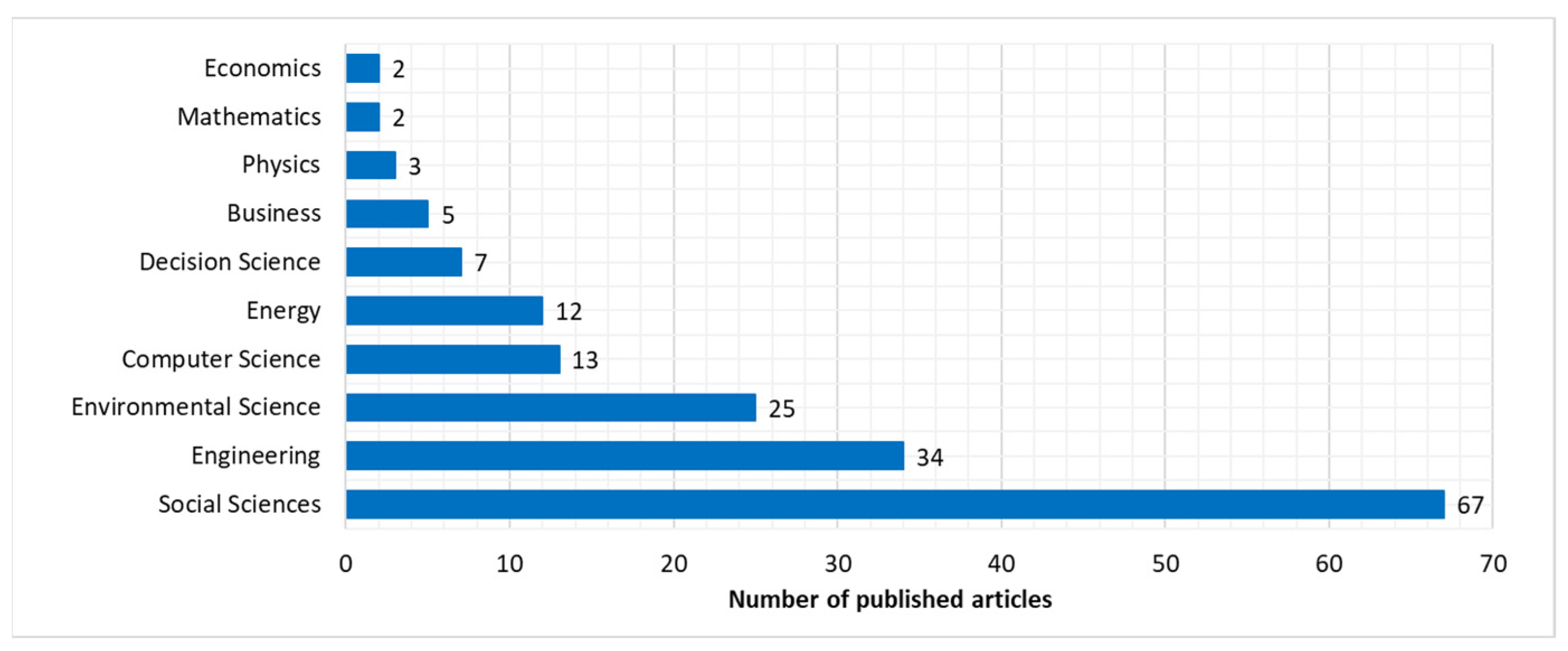


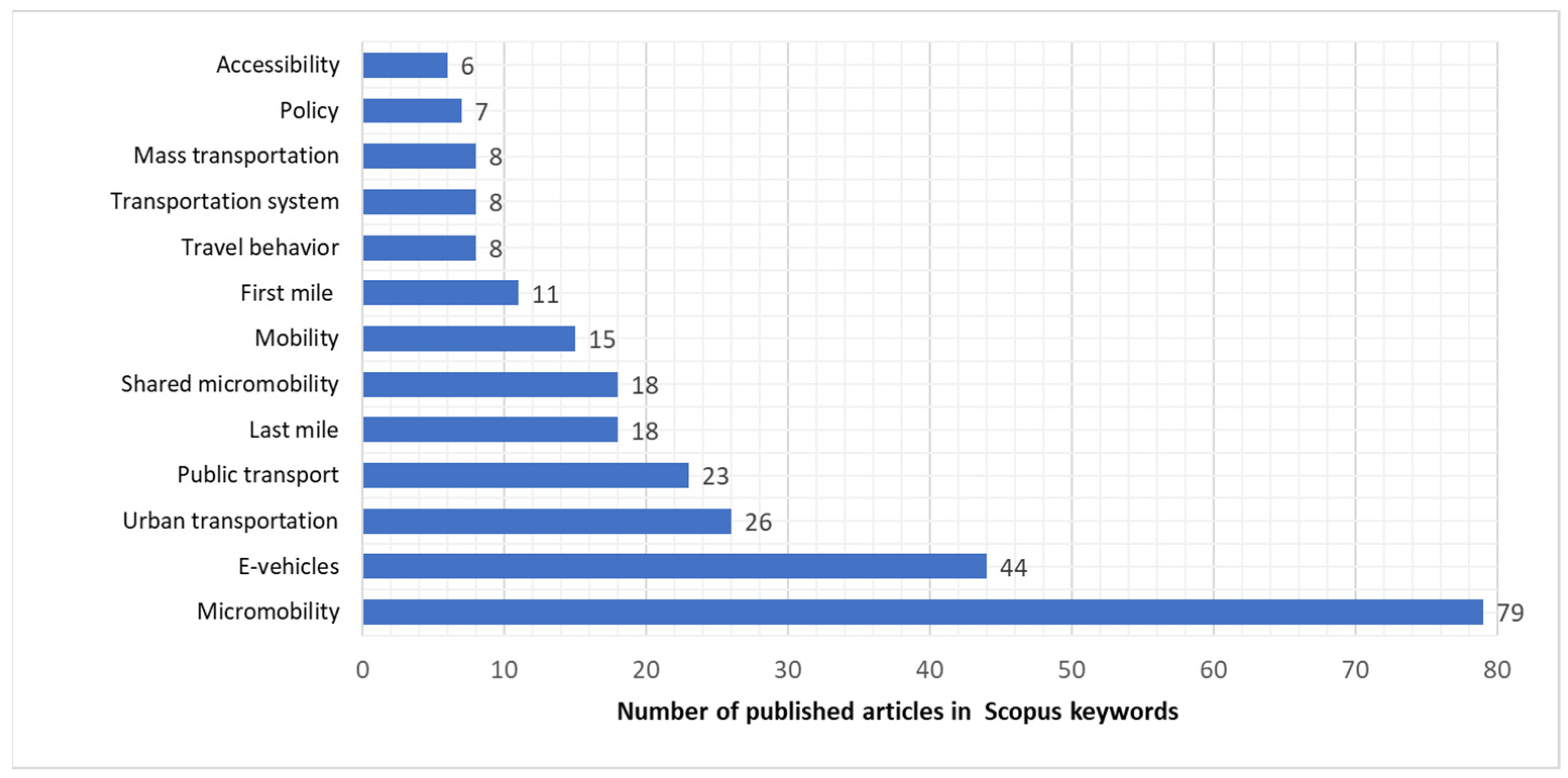
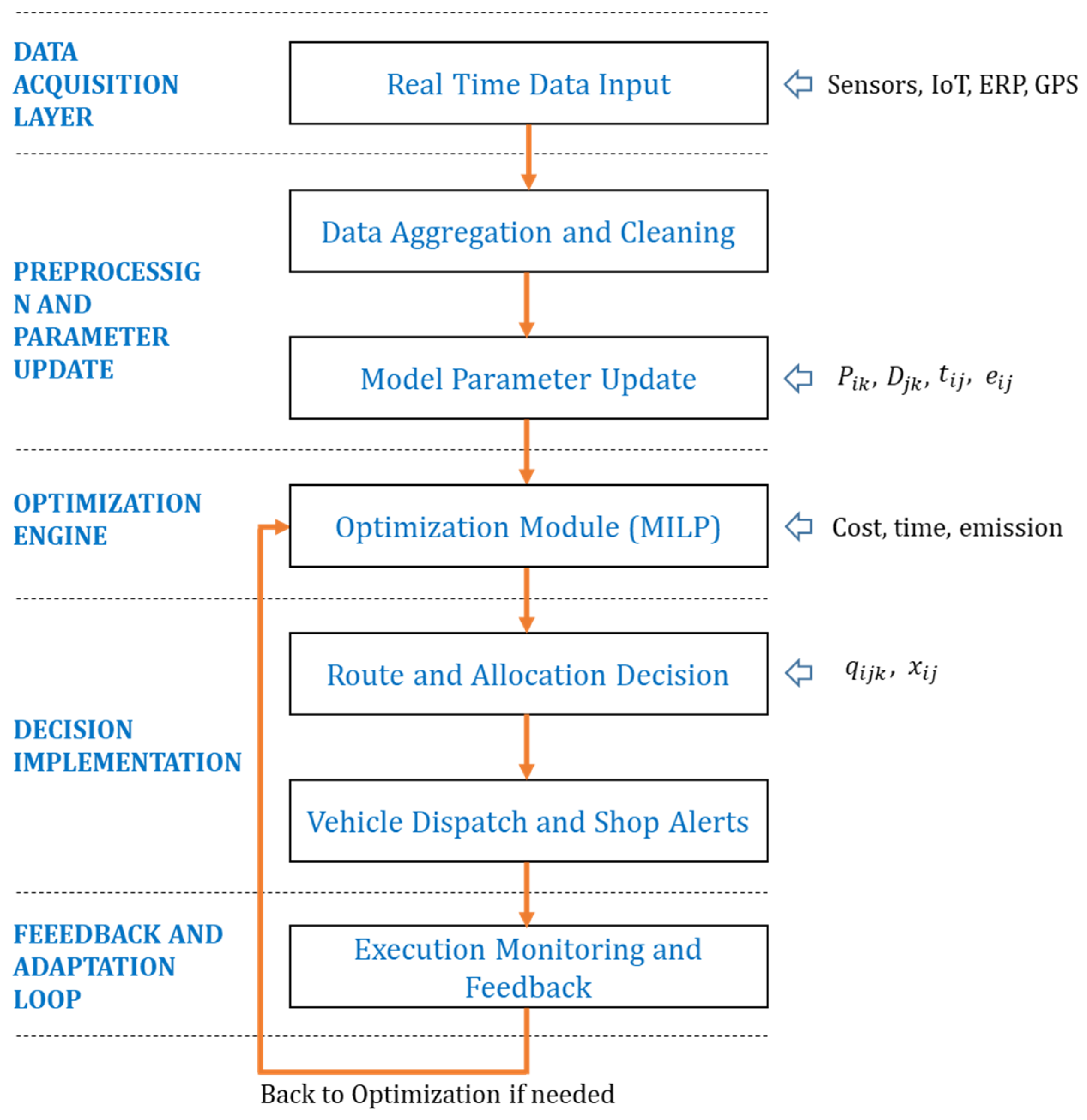
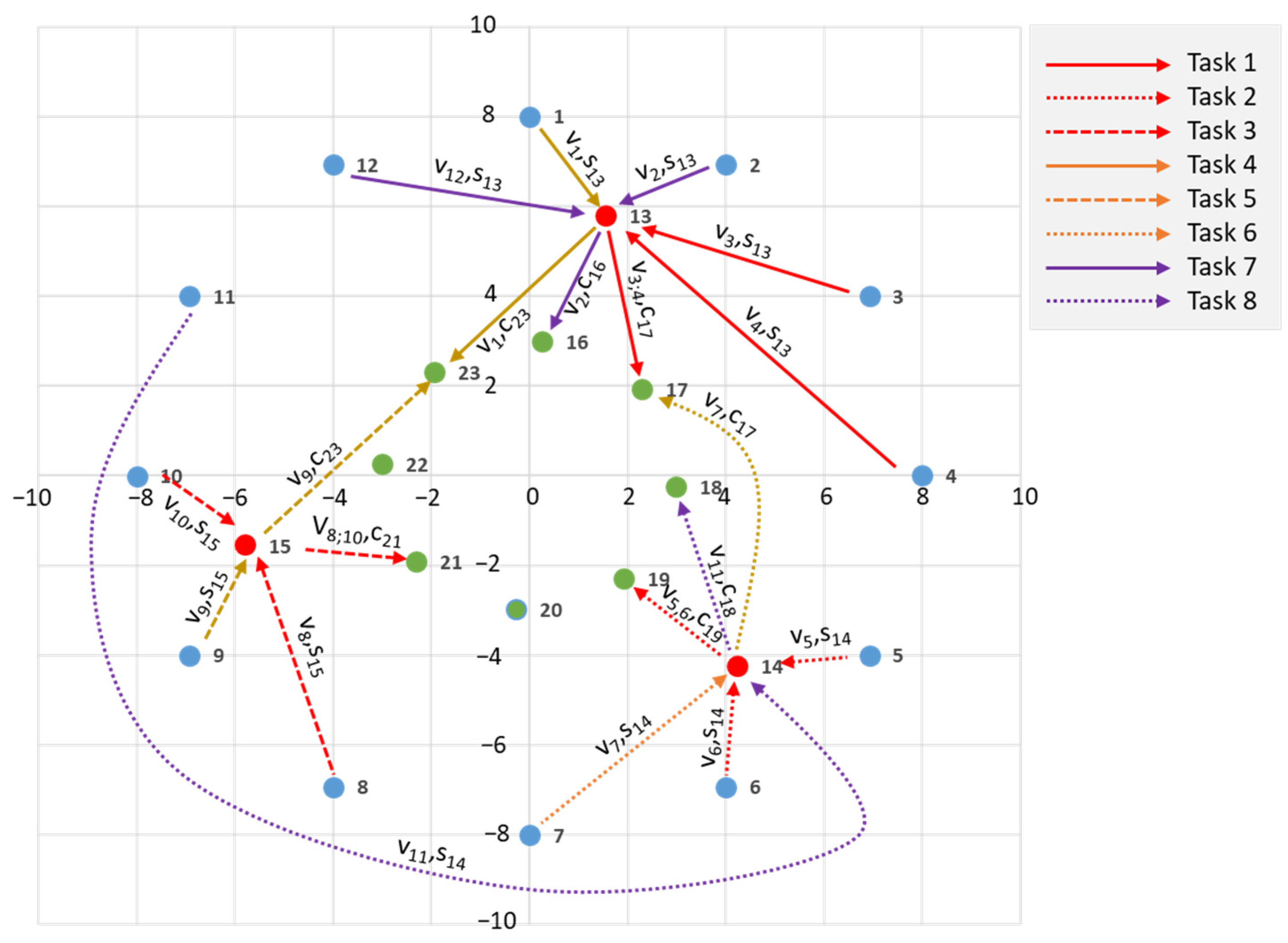

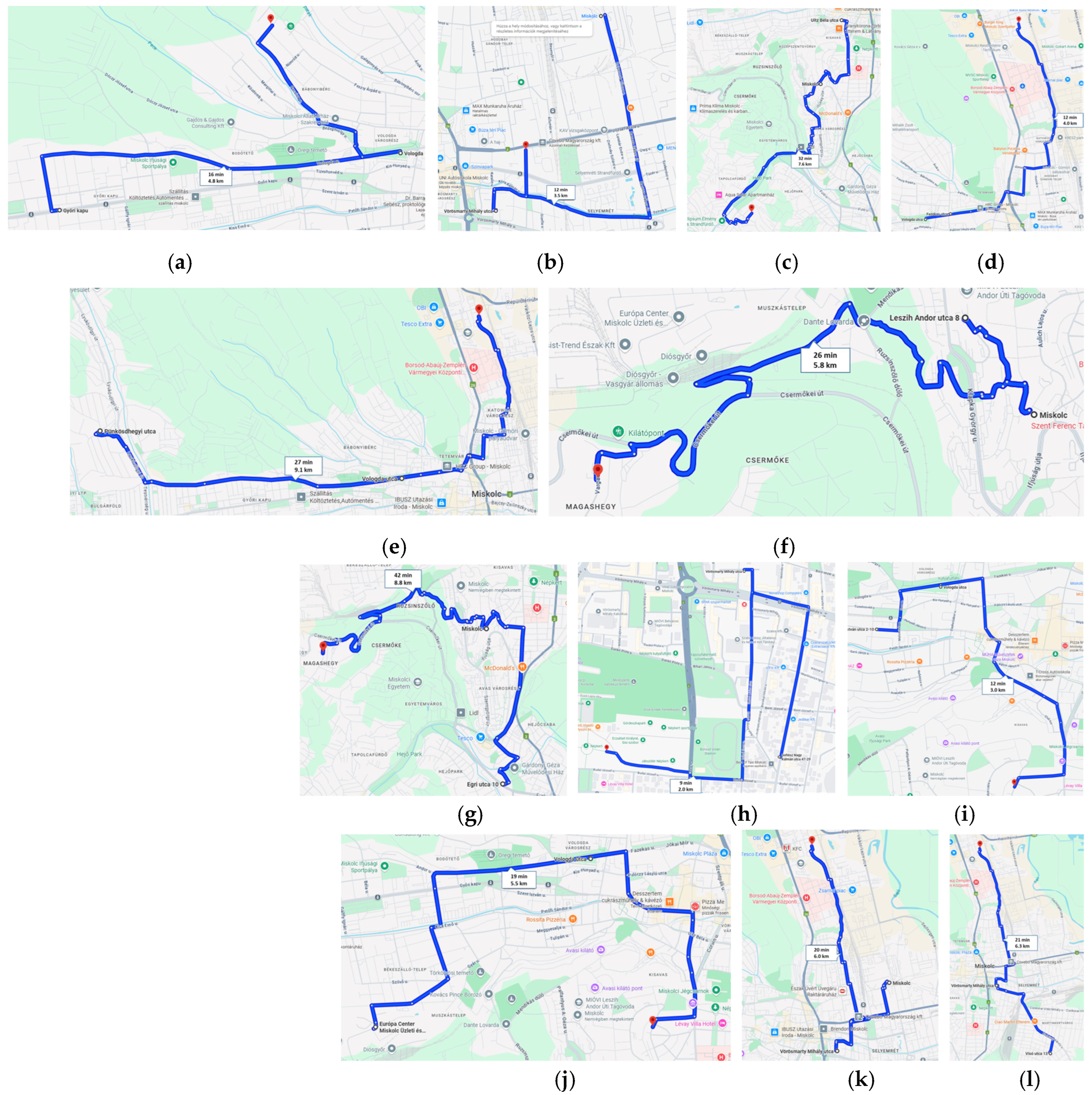

| Category | Authors (Year) | Methods Used | Key Findings/Contribution |
|---|---|---|---|
| Integration of Micromobility and Public Transit | Liu and Miller (2022) [14] | GIS-based accessibility analysis | Dockless micromobility improves public transit access; spatially varies. |
| Tyndall (2022) [15] | Econometric modeling | Micromobility complements rail transit; overlap in short trips. | |
| Yin et al. (2024) [16] | Spatiotemporal analytics | Micromobility supports first-/last-mile; varies by time and location. | |
| Shaheen et al. (2021) [17] | Policy analysis | Curb policy must adapt to enable transit integration. | |
| Mohiuddin et al. (2024) [18] | Survey + regression | Bike-share complements transit under certain conditions. | |
| Cui and Zhang (2024) [19] | Systematic literature review | Coordination and infrastructure are key for integration. | |
| Beale et al. (2023) [20] | Equity mapping + case study | Payment integration improves access for marginalized users. | |
| Vinagre Díaz et al. (2024) [21] | Machine learning classification | Many scooter trips connect to or replace public transport. | |
| Javadiansr et al. (2024) [22] | GIS + time-series | Micromobility and transit show synchronized demand patterns. | |
| User Behavior and Socio-Demographics | Campisi et al. (2021) [23] | Survey + statistical analysis | Women avoid scooters due to safety/infrastructure concerns. |
| Parnell et al. (2023) [24] | Survey + comparative stats | Gender differences in perceived safety and preferences. | |
| Wallgren et al. (2023) [25] | Survey + media analysis | Users view scooters more positively than media portrayal. | |
| Turoń et al. (2023) [26] | Urban survey | Users are positive; parking cited as main concern. | |
| Kim et al. (2023) [27] | 3-year cross-sectional survey | User behavior consistent; demographic factors important. | |
| Dias et al. (2024) [28] | Survey | Use driven by convenience, cost, and eco-awareness. | |
| Romm et al. (2022) [29] | Trip data analysis | First- and last-mile use patterns differ by trip type. | |
| Azimi et al. (2021) [30] | Mode choice modeling | Trip length and land use affect access mode choice. | |
| Hong et al. (2023) [31] | Survey + regression | Parking preferences favor micromobility for last mile. | |
| Forecasting, Optimization, and Planning | Phithakkitnukoon et al. (2021) [32] | Deep Learning (Masked FCN) | Model predicts scooter demand with high accuracy. |
| Luo et al. (2021) [33] | Optimization modeling | Designs intermodal networks under uncertainty. | |
| Arias-Molinares et al. (2023) [34] | GIS + spatiotemporal | Key factors for hub placement identified. | |
| Colovic et al. (2024) [35] | Multi-objective optimization | Efficient scooter parking reduces traffic conflicts. | |
| Kazmaier et al. (2020) [36] | Life Cycle Analysis | Sustainability depends on usage intensity and lifespan. | |
| Hamerska et al. (2022) [37] | Service quality model (MMQUAL) | Evaluates shared micromobility service dimensions. | |
| Schwinger et al. (2022) [38] | Spatiotemporal data analysis | Micromobility fills spatial transit gaps. | |
| Oliveira et al. (2022) [39] | Facility location modeling | Locating lockers improves freight-transit synergy. | |
| Zhang et al. (2024) [41] | Policy review | Calls for better regulation and inter-agency data coordination. | |
| Safety, Perception, and Equity | Sundqvist-Andberg et al. (2021) [42] | Qualitative + policy review | Business models need stronger safety and sustainability focus. |
| Štefancová et al. (2022) [43] | Statistical comparison | Micromobility rose as public transit use declined. | |
| Huang et al. (2024) [44] | Survey + regression | High usage among young people in dense transit zones. | |
| Dzięcielski et al. (2024) [45] | Regression + GIS | Demand driven by urban density and infrastructure. | |
| Eom et al. (2023) [46] | Survey | Micromobility preferred for subway access. | |
| Nawaro (2021) [47] | Comparative mode analysis | Scooters and bikes compete or complement depending on context. | |
| Miller et al. (2023) [48] | Experimental simulation | Cargo bike tire model improves micromobility simulations. | |
| Aguilera-García et al. (2024) [49] | Survey + regression | Choice between shared/private scooters depends on age, income. |
| Parameter | Description |
|---|---|
| Set of producers | |
| Set of delivery locations (customers) | |
| Set of product types (e.g., bread, vegetables) | |
| Available quantity of product k at producer i in [kg] | |
| Demand of product k at location j in [kg] | |
| Weight per unit of product k in [kg] | |
| Volume per unit of product k in [m3] | |
| Cost per unit delivered from i to j in [EURO/kg] | |
| Delivery time from i to j in [min] | |
| CO2 emissions per unit delivered from i to j in [kg CO2] | |
| Weight capacity of one micromobility vehicle in [kg] | |
| Volume capacity of one micromobility vehicle in [m3] | |
| Total number of available micromobility vehicles in [pcs] | |
| Maximum allowable delivery time (optional) in [min] | |
| Maximum allowable emissions (optional) in [kg CO2] |
| Task | Weight | Volume | From | To |
|---|---|---|---|---|
| 1 | 12 | 9 | ID_13 | ID_17 |
| 2 | 7 | 7 | ID_14 | ID_19 |
| 3 | 8 | 6 | ID_15 | ID_21 |
| 4 | 10 | 5 | ID_13 | ID_23 |
| 5 | 7 | 4 | ID_15 | ID_23 |
| 6 | 6 | 2 | ID_14 | ID_17 |
| 7 | 5 | 6 | ID_13 | ID_16 |
| 8 | 8 | 4 | ID_14 | ID_18 |
| ID of Idle Micromobility Vehicle | Producers | ||
|---|---|---|---|
| ID_13 | ID_14 | ID_15 | |
| ID_1 | 2.697 | 12.957 | 11.173 |
| ID_2 | 2.697 | 11.173 | 12.957 |
| ID_3 | 5.667 | 8.669 | 13.883 |
| ID_4 | 8.669 | 5.667 | 13.883 |
| ID_5 | 11.173 | 2.697 | 12.957 |
| ID_6 | 12.957 | 2.697 | 11.173 |
| ID_7 | 13.883 | 5.667 | 8.669 |
| ID_8 | 13.883 | 8.669 | 5.667 |
| ID_9 | 12.957 | 11.173 | 2.697 |
| ID_10 | 11.173 | 12.957 | 2.697 |
| ID_11 | 8.669 | 13.883 | 5.667 |
| ID_12 | 5.667 | 13.883 | 8.669 |
| Producers’ ID | Customers | |||||||
|---|---|---|---|---|---|---|---|---|
| ID_16 | ID_17 | ID_18 | ID_19 | ID_20 | ID_21 | ID_22 | ID_23 | |
| ID_13 | 3.090 | 3.938 | 6.225 | 8.102 | 8.970 | 8.631 | 7.159 | 4.935 |
| ID_14 | 8.255 | 6.470 | 4.174 | 3.023 | 4.675 | 6.938 | 8.519 | 8.992 |
| ID_15 | 7.571 | 8.811 | 8.879 | 7.760 | 5.717 | 3.518 | 3.342 | 5.458 |
| ID of Idle Micromobility Vehicle | Parameters | ||||
|---|---|---|---|---|---|
| Cost per Unit [EURO/pcs · km] | Speed [km/h] | CO2 Emission [g/km] | Weight Capacity [kg/Vehicle] | Volume Capacity [dm3/Vehicle] | |
| ID_1 | 0.42 | 20 | 48 | 10 | 11 |
| ID_2 | 0.38 | 25 | 54 | 12 | 3 |
| ID_3 | 0.25 | 30 | 48 | 15 | 4 |
| ID_4 | 0.45 | 25 | 24 | 5 | 5 |
| ID_5 | 0.62 | 20 | 54 | 10 | 4 |
| ID_6 | 0.55 | 40 | 42 | 8 | 3 |
| ID_7 | 0.42 | 30 | 24 | 6 | 2 |
| ID_8 | 0.24 | 32 | 24 | 5 | 3 |
| ID_9 | 0.33 | 25 | 30 | 8 | 4 |
| ID_10 | 0.42 | 22 | 24 | 6 | 5 |
| ID_11 | 0.25 | 15 | 28.8 | 8 | 4 |
| ID_12 | 0.34 | 30 | 24 | 4 | 3 |
| ID of Idle Micromobility Vehicle | Tasks | |||||||
|---|---|---|---|---|---|---|---|---|
| ID_16 | ID_17 | ID_18 | ID_19 | ID_20 | ID_21 | ID_22 | ID_23 | |
| ID_1 | 0 | 0 | 0 | 1 | 0 | 0 | 0 | 0 |
| ID_2 | 0 | 0 | 0 | 0 | 0 | 0 | 1 | 0 |
| ID_3 | 1 | 0 | 0 | 0 | 0 | 0 | 0 | 0 |
| ID_4 | 1 | 0 | 0 | 0 | 0 | 0 | 0 | 0 |
| ID_5 | 0 | 1 | 0 | 0 | 0 | 0 | 0 | 0 |
| ID_6 | 0 | 1 | 0 | 0 | 0 | 0 | 0 | 0 |
| ID_7 | 0 | 0 | 0 | 0 | 0 | 1 | 0 | 0 |
| ID_8 | 0 | 0 | 1 | 0 | 0 | 0 | 0 | 0 |
| ID_9 | 0 | 0 | 0 | 0 | 1 | 0 | 0 | 0 |
| ID_10 | 0 | 0 | 1 | 0 | 0 | 0 | 0 | 0 |
| ID_11 | 0 | 0 | 0 | 0 | 0 | 0 | 0 | 1 |
| ID_12 | 0 | 0 | 0 | 0 | 0 | 0 | 1 | 0 |
| ID of Idle Micromobility Vehicle | Parameters | |||
|---|---|---|---|---|
| Length of Routes [km] | Cost [EURO] | CO2 Emission [g] | Delivery Time [min] | |
| ID_1 | 7.63 | 32.05 | 366.30 | 22.89 |
| ID_2 | 5.79 | 26.39 | 312.46 | 13.89 |
| ID_3 | 9.61 | 36.02 | 461.07 | 19.21 |
| ID_4 | 12.61 | 28.37 | 302.58 | 30.26 |
| ID_5 | 5.72 | 35.46 | 308.84 | 17.16 |
| ID_6 | 5.72 | 25.16 | 240.21 | 8.58 |
| ID_7 | 12.14 | 30.59 | 291.30 | 24.27 |
| ID_8 | 9.18 | 11.02 | 220.43 | 17.22 |
| ID_9 | 8.15 | 21.53 | 244.62 | 19.57 |
| ID_10 | 6.21 | 15.66 | 149.14 | 16.95 |
| ID_11 | 18.06 | 36.11 | 520.03 | 72.23 |
| ID_12 | 8.76 | 11.91 | 210.17 | 17.51 |
| Total | 109.57 | 310.27 | 3627.15 | 279.74 |
| Task | Weight | Volume | From | To |
|---|---|---|---|---|
| 1 | 10 | 30 | ID_NB | ID_20 |
| 2 | 15 | 20 | ID_CB | ID_23 |
| 3 | 8 | 45 | ID_KB | ID_18 |
| 4 | 30 | 20 | ID_NB | ID_21 |
| 5 | 11 | 24 | ID_KB | ID_19 |
| 6 | 12 | 23 | ID_CB | ID_16 |
| 7 | 18 | 20 | ID_NB | ID_17 |
| 8 | 20 | 10 | ID_CB | ID_21 |
| Type of Location | ID of Location | Latitude | Longitude |
|---|---|---|---|
| Idle cargo e-tries or e-scooters within the predefined time window | ID_1 | 48.106972 | 20.778530 |
| ID_2 | 48.109617 | 20.805514 | |
| ID_3 | 48.101090 | 20.783889 | |
| ID_4 | 48.103764 | 20.768504 | |
| ID_5 | 48.102601 | 20.740796 | |
| ID_6 | 48.094024 | 20.750787 | |
| ID_7 | 48.112712 | 20.713820 | |
| ID_8 | 48.094911 | 20.796513 | |
| ID_9 | 48.112592 | 20.804776 | |
| ID_10 | 48.094503 | 20.772994 | |
| ID_11 | 48.086682 | 20.811284 | |
| ID_12 | 48.068349 | 20.781607 | |
| Bakeries | ID_NB | 48.106353 | 20.774373 |
| ID_CB | 48.100402 | 20.794958 | |
| ID_KB | 48.089532 | 20.778257 | |
| Customers, location of orders | ID_16 | 48.095071 | 20.788859 |
| ID_17 | 48.094151 | 20.781122 | |
| ID_18 | 48.066120 | 20.759499 | |
| ID_19 | 48.086225 | 20.744807 | |
| ID_20 | 48.114831 | 20.761600 | |
| ID_21 | 48.128068 | 20.789880 | |
| ID_22 | 48.098661 | 20.867083 | |
| ID_23 | 48.104197 | 20.797741 |
| ID Of Idle Micromobility Vehicle | Producers | ||
|---|---|---|---|
| ID_NB | ID_CB | ID_KB | |
| ID_1 | 300 | 1800 | 2500 |
| ID_2 | 3100 | 1900 | 3800 |
| ID_3 | 1200 | 950 | 1700 |
| ID_4 | 700 | 2300 | 2800 |
| ID_5 | 2600 | 4400 | 4300 |
| ID_6 | 2700 | 3900 | 3200 |
| ID_7 | 5100 | 7000 | 7200 |
| ID_8 | 2600 | 800 | 1800 |
| ID_9 | 3400 | 2300 | 4200 |
| ID_10 | 2300 | 2400 | 800 |
| ID_11 | 4300 | 2300 | 4300 |
| ID_12 | 5200 | 4300 | 3200 |
| Producers’ ID | Customers | |||||||
|---|---|---|---|---|---|---|---|---|
| ID_16 | ID_17 | ID_18 | ID_19 | ID_20 | ID_21 | ID_22 | ID_23 | |
| ID_NB | 2000 | 2200 | 6300 | 4400 | 1600 | 3800 | 7800 | 1900 |
| ID_CB | 1100 | 1600 | 6400 | 5400 | 3400 | 3700 | 6600 | 700 |
| ID_KB | 1200 | 750 | 4500 | 4200 | 4300 | 5300 | 8500 | 2700 |
| ID of Idle Micromobility Vehicle | Parameters | ||||
|---|---|---|---|---|---|
| Cost per Unit [EURO/pcs*km] | Speed [km/h] | CO2 Emission [g/km] | Weight Capacity [kg/Vehicle] | Volume Capacity [dm3/Vehicle] | |
| ID_1 | 0.23 | 30 | 48 | 20 | 40 |
| ID_2 | 0.35 | 30 | 54 | 15 | 30 |
| ID_3 | 0.24 | 30 | 48 | 25 | 50 |
| ID_4 | 0.52 | 30 | 24 | 17.5 | 35 |
| ID_5 | 0.53 | 40 | 54 | 17.5 | 35 |
| ID_6 | 0.29 | 40 | 42 | 5 | 10 |
| ID_7 | 0.34 | 3 | 24 | 10 | 20 |
| ID_8 | 0.62 | 20 | 24 | 12.5 | 25 |
| ID_9 | 0.42 | 25 | 30 | 15 | 30 |
| ID_10 | 0.53 | 3 | 24 | 10 | 20 |
| ID_11 | 0.4 | 30 | 28.8 | 7.5 | 15 |
| ID_12 | 0.25 | 35 | 24 | 5 | 10 |
| ID of Idle Micromobility Vehicle | Tasks | |||||||
|---|---|---|---|---|---|---|---|---|
| ID_16 | ID_17 | ID_18 | ID_19 | ID_20 | ID_21 | ID_22 | ID_23 | |
| ID_1 | 0 | 0 | 0 | 1 | 0 | 0 | 0 | 0 |
| ID_2 | 0 | 0 | 0 | 0 | 0 | 0 | 0 | 1 |
| ID_3 | 0 | 0 | 1 | 0 | 0 | 0 | 0 | 0 |
| ID_4 | 0 | 0 | 0 | 0 | 0 | 0 | 1 | 0 |
| ID_5 | 1 | 0 | 0 | 0 | 0 | 0 | 0 | 0 |
| ID_6 | 0 | 0 | 0 | 0 | 0 | 0 | 1 | 0 |
| ID_7 | 0 | 0 | 0 | 1 | 0 | 0 | 0 | 0 |
| ID_8 | 0 | 0 | 0 | 0 | 0 | 1 | 0 | 0 |
| ID_9 | 0 | 1 | 0 | 0 | 0 | 0 | 0 | 0 |
| ID_10 | 0 | 0 | 0 | 0 | 1 | 0 | 0 | 0 |
| ID_11 | 0 | 0 | 0 | 0 | 0 | 0 | 0 | 1 |
| ID_12 | 0 | 0 | 0 | 0 | 1 | 0 | 0 | 0 |
| ID of Idle Micromobility Vehicle | Parameters | |||
|---|---|---|---|---|
| Length of Routes [km] | Cost [EURO] | CO2 Emission [g] | Delivery Time [min] | |
| ID_1 | 4.10 | 18.86 | 197 | 8.20 |
| ID_2 | 5.60 | 29.40 | 302 | 11.20 |
| ID_3 | 6.20 | 37.20 | 298 | 12.40 |
| ID_4 | 2.90 | 26.39 | 70 | 5.80 |
| ID_5 | 4.20 | 38.96 | 227 | 6.30 |
| ID_6 | 4.90 | 7.11 | 206 | 7.35 |
| ID_7 | 8.90 | 30.26 | 214 | 178.00 |
| ID_8 | 1.90 | 14.73 | 46 | 5.70 |
| ID_9 | 3.00 | 18.90 | 90 | 7.20 |
| ID_10 | 5.00 | 26.50 | 120 | 100.00 |
| ID_11 | 6.00 | 18.00 | 173 | 12.00 |
| ID_12 | 7.40 | 9.25 | 178 | 12.69 |
| Total | 60.10 | 275.55 | 2118.60 | 366.84 |
Disclaimer/Publisher’s Note: The statements, opinions and data contained in all publications are solely those of the individual author(s) and contributor(s) and not of MDPI and/or the editor(s). MDPI and/or the editor(s) disclaim responsibility for any injury to people or property resulting from any ideas, methods, instructions or products referred to in the content. |
© 2025 by the authors. Licensee MDPI, Basel, Switzerland. This article is an open access article distributed under the terms and conditions of the Creative Commons Attribution (CC BY) license (https://creativecommons.org/licenses/by/4.0/).
Share and Cite
Bányai, Á.; Kaczmar, I.; Bányai, T. Green Micromobility-Based Last-Mile Logistics from Small-Scale Urban Food Producers. Systems 2025, 13, 785. https://doi.org/10.3390/systems13090785
Bányai Á, Kaczmar I, Bányai T. Green Micromobility-Based Last-Mile Logistics from Small-Scale Urban Food Producers. Systems. 2025; 13(9):785. https://doi.org/10.3390/systems13090785
Chicago/Turabian StyleBányai, Ágota, Ireneusz Kaczmar, and Tamás Bányai. 2025. "Green Micromobility-Based Last-Mile Logistics from Small-Scale Urban Food Producers" Systems 13, no. 9: 785. https://doi.org/10.3390/systems13090785
APA StyleBányai, Á., Kaczmar, I., & Bányai, T. (2025). Green Micromobility-Based Last-Mile Logistics from Small-Scale Urban Food Producers. Systems, 13(9), 785. https://doi.org/10.3390/systems13090785







